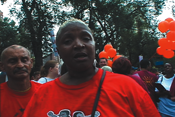 |
||||
| Still from Walking with FUREE (dir. Miriam Perez, 2005). Used with permission from Third World Newsreel. | ||||
|
||||
Journal Issue 2.2
Fall 2010
Edited by Agatha Beins, Deanna Utroske, Julie Ann Salthouse, Jillian Hernandez, and
Karen Alexander
Editorial Assistant: Julie Chatzinoff
Living Broke in Boom Times: Lessons from the Movement to End Poverty. Directed by Peter Kinoy and Pamela Yates. New York: Skylight Pictures, 2007.
Walking with FUREE. Directed by Miriam Perez. New York: Third World Newsreel, 2005.
Reviewed by Premilla Nadasen
Living Broke in Boom Times and Walking with FUREE document poor people’s activism over the past twenty years. The men, women, and children interviewed in the films characterize their movements as completing the unfinished business of the civil rights movement and the poor people’s campaign that was cut short in the 1960s. There does seem to be a tangible connection between these contemporary activists and those of the previous generation. As “outlaws” and “outriders,” their strategies of civil disobedience—squatting, housing takeovers, and stealing food—were illegal means to a higher moral end of achieving a modicum of economic justice. Their chants, their celebration of interracial unity, and their rationale for breaking unjust laws all echo aspects of the civil rights struggle. But there is more to this story than unfulfilled civil rights promises.
Living Broke condenses in a little over an hour three films made in the 1990s by the directors Pamela Yates and Peter Kinoy—Takeover, Poverty Outlaw, and Outriders. The film provides an overview of homeless activism that culminated in the May 1, 1990, nationwide takeovers of abandoned government-owned houses; the Kensington Welfare Rights Union’s effort to start a community center in Philadelphia and organize a squatter campaign in a city park; and the Poor People’s Economic Human Rights Campaign 1998 thirty-day national bus tour of impoverished communities. Narrators of Living Broke consider the strengths and weaknesses of their campaigns and their own political growth and evolution. Walking with FUREE, a short 10-minute film, chronicles Wanda Imasuen’s political awakening. An unemployed mother on welfare living in New York City, she became involved in Families United for Racial and Economic Equality (FUREE), launching her career as a community organizer.
The two films document grassroots community organizing during a period of ostensible economic growth. These were not top-down movements, but emerged as poor people became fed up with obstacles to obtaining a better life for themselves and their children. These films give a platform to the marginalized—folks who generally have little voice in the public debate. At their core, the films are about how ordinary people can band together and enact social change. Cinematically the films convey the chaos of contemporary community organizing. They depict heart-wrenching stories of battles with cops, conflicts with the welfare office, health problems, and children placed in foster care. Despite the countless personal tragedies, communities united and fought back.
In addition to placing these movements in a trajectory of civil rights activity, Living Broke and Walking with FUREE also enhance our portrait of feminism. The scope of contemporary women’s activism is sometimes confined to workplace equity, reproductive rights, and sexual harassment. In many feminist academic and popular accounts the period 1990-2010 is either the doldrums of activism or dominated by Third Wavers seeking a journey of personal empowerment. Missing in this narrative are grassroots efforts by poor women. These films, however, offer an alternative view of women’s political engagement over the past two decades. While the campaigns the films document are not women’s movements per se, many of the central actors are women and mothers. Indeed, their history as laid-off workers, victims of domestic violence, and mothers trying to provide for their children frames their activism.
The past two decades have left many progressives with the sense that there is little opposition to neoliberal policies that have shredded the safety net, shrunk the manufacturing sector, and left the poor with few options for basic survival. Women’s success in the workplace is routinely touted today. Many analyses of the recent recession suggest that women have fared better than men, reinforcing the mythical belief that women have overcome barriers to inequality. While women’s overall unemployment rate may be lower than that of men, such flat statistics do not take into account underemployment, the lack of health care for those who are employed, low wages, or the high cost of child care and housing. In this dire economic climate, with inequality at one of its highest levels in U.S. history, there is ample reason to expose students to models of social change that can inspire. These films demonstrate that there is a vibrant, grassroots, community-based movement, led largely by women, working to restore some measure of civil society in America. Living Broke is divided into five thematic chapters so educators can easily show just one 15-minute segment, and FUREE, because of its length, can easily be incorporated into a larger class discussion. The films can be paired with a wonderful anthology, The Sex of Class: Women Transforming American Labor, edited by Dorothy Sue Cobble, which looks at both class differences among women as well as women’s labor organizing.1 Students watching these films will come away with a vastly different picture of the boom times of the 1990s. They will rethink the nature of women’s political activism. And they will have a much better sense of how disempowered people can organize and mobilize to effect social change.
Premilla Nadasen is an associate professor of history at Queens College, CUNY. She is the author of Welfare Warriors: The Welfare Rights Movement in the United States (New York: Routledge, 2005) and is currently writing a book on the history of domestic worker organizing.
Copyright © 2014. All rights reserved.